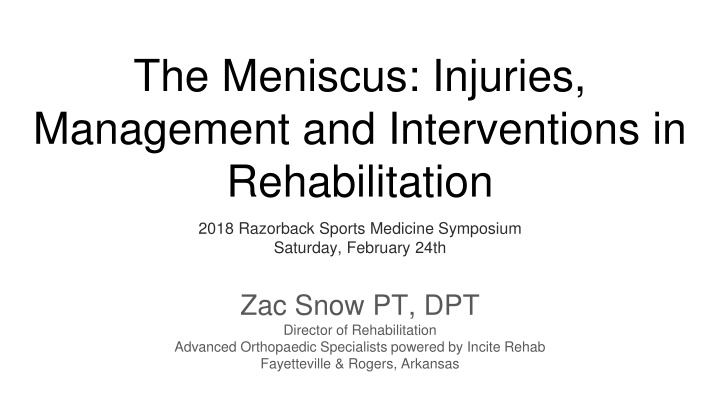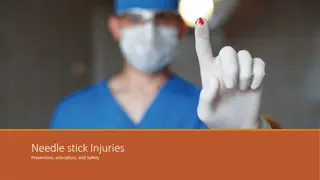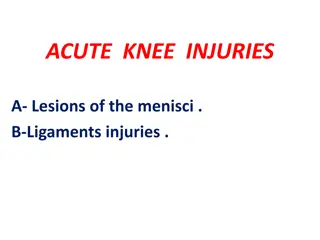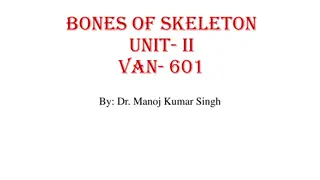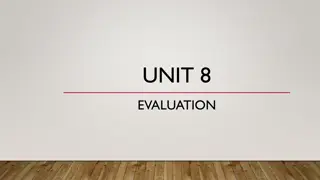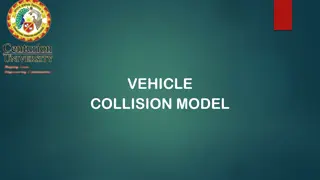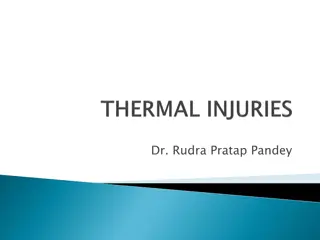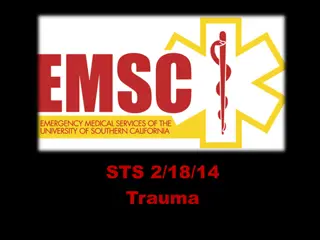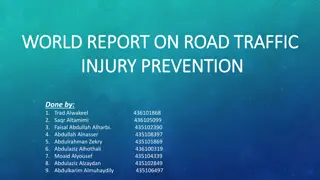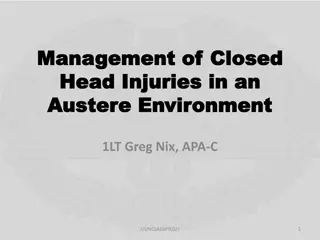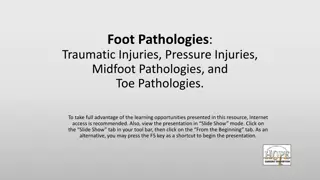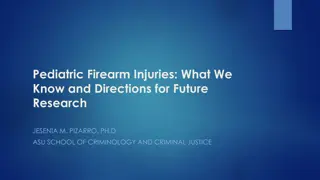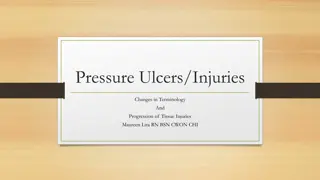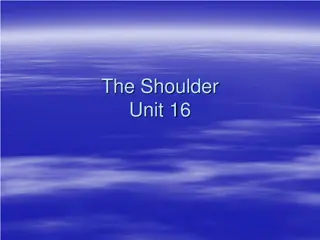Meniscus Injuries: Anatomy, Evaluation, and Management
Explore the intricate details of meniscus anatomy, including the structures, attachments, and functions of the medial and lateral menisci. Learn about the mechanisms of injury, diagnostic approaches, operative and non-operative management strategies, and the importance of rehabilitation in restoring functional movement. Delve into the complexities of meniscus injuries to enhance your understanding of effective treatment and intervention techniques.
Download Presentation

Please find below an Image/Link to download the presentation.
The content on the website is provided AS IS for your information and personal use only. It may not be sold, licensed, or shared on other websites without obtaining consent from the author.If you encounter any issues during the download, it is possible that the publisher has removed the file from their server.
You are allowed to download the files provided on this website for personal or commercial use, subject to the condition that they are used lawfully. All files are the property of their respective owners.
The content on the website is provided AS IS for your information and personal use only. It may not be sold, licensed, or shared on other websites without obtaining consent from the author.
E N D
Presentation Transcript
The Meniscus: Injuries, Management and Interventions in Rehabilitation 2018 Razorback Sports Medicine Symposium Saturday, February 24th Zac Snow PT, DPT Director of Rehabilitation Advanced Orthopaedic Specialists powered by Incite Rehab Fayetteville & Rogers, Arkansas
Objectives 1. Anatomy a. Identify anatomical structures of the menisci and related structures 2. Evaluation a. Recognize the mechanism of injury b. Understand the common history and diagnostics 3. Operative Management/Post-Operative Management a. Comprehend post-operative implications b. Apply implications to rehabilitation timeline and goals c. Apply knowledge of exercise to restore functional movement of the patient 4. Non-Operative Management a. Use prior knowledge of anatomy and mechanism of injury for outcomes b. Apply knowledge of exercise to restore functional movement of the patient
Anatomy Medial and Lateral Menisci
Anatomy - Medial and Lateral Menisci Medial Meniscus C Shaped Surrounded by ACL, PCL, and MCL Shares medial fibers with MCL Lateral Meniscus Circular Surrounded by PCL, LCL, and partially by ACL Shares medial fibers with ACL http://boneandspine.com/meniscus-anatomy- function-and-significance/
Anatomy - Medial and Lateral Menisci Rest atop the tibial plateau House each femoral condyle to secure the joint Both structures translate during flexion/extension of the knee Translate with slight rotation at the knee
Anatomy - Medial and Lateral Menisci Medial Meniscus Attachment: superficial in relation to the ACL; deep in relation to the PCL Provides wide base for femoral condyle Lateral Meniscus Attachment: deep in relation to the ACL; deep to the attachment of the medial meniscus posteriorly http://boneandspine.com/meniscus-anatomy-function-and-significance/
Anatomy - Medial and Lateral Menisci Transverse Ligament: join menisci anteriorly ~70% of knees, the lateral meniscus attaches to femur by either: posterior meniscofemoral ligament of Wrisberg (superficial to the PCL) anterior meniscofemoral ligament of Humphreys (deep to the PCL) [not pictured] Both occur in 6% of knees Warren R, Arnoczky SP, Wickiewicz TL. Anatomy of the Knee. In: Nicholas JA, Hershman EB, eds. The Lower Extremity and Spine in Sports Medicine. St. Louis, Mo: Mosby; 1986:657-694.
Anatomy - Discoid Meniscus Primarily affects the lateral meniscus Watanabe (1974) classified: Incomplete Vary in coverage Complete Vary in coverage Wrisberg-ligament types Normal appearance No posterior coronary attachment Uncommon finding present in 0.4% - 5% arthroscopic studies Incomplete Complete Wrisberg-ligament variant Neuschwander DC, Dres D, Finney TP. Lateral meniscal variant with absence of the posterior coronary ligament. J Bone Joint Surg Am. 1992;74: 1186-1190.
Related Anatomical Structures - Blood Supply & Innervation Blood Supply Typically avascular Arnoczky & Warren (1982) showed blood supply located at peripheral 10-30% (red-red zone) Inner free margins nourished by synovial fluid (white-white zone) Femur Peripheral blood supply Innervation Peripheral Nociceptors (free nerve endings) Mechanoreceptors Ruffini corpuscles Pacinian corpuscles Golgi tendon organs Tibia Arnoczky SP, Warren RF. Microvasculature of the human meniscus. Am J Sports Med. 1982;10:90-95.
Related Anatomy Collateral Ligaments Cruciate Ligaments Synovium Hoop Stress Principle
Related Anatomical Structures - Collateral Ligaments Medial Collateral Ligament (MCL) Origin: proximal medial femoral condyle Insertion: distal medial tibial plateau Resists valgus forces Shares fibers with medial meniscus Lateral Collateral Ligament (LCL) Origin: proximal lateral femoral condyle Insertion: distal fibular head Part of the posteriolateral corner due to oblique orientation
Related Anatomical Structures - Cruciate Ligaments Anterior Cruciate Ligament (ACL) 2 bundles: anteriomedial and posteriolateral Origin: distal medial wall of the lateral femoral condyle Insertion: tibial plateau (respectively) Shares anterior fibers with anterior horn of the lateral meniscus Posterior Cruciate Ligament (PCL) Origin: posteriolateral medial femoral condyle Insertion: posteriolateral on the tibial plateau http://boneandspine.com/meniscus-anatomy-function-and-significance/
Related Anatomical Structures - Synovium Knee Joint Synovium Soft tissue capsule Retains synovial fluid Provides lubrication Nourishes menisci http://aspiruslibrary.org/pictures/grey/kneejoint.gif
Hoop Stress Principle Weightbearing produces axial forces Meniscal compression results in circumferential (hoop) stress Axial forces are converted to tensile stress along circumferential collagen fibers Seedhom and Hargreaves (1979) Reported 70% of the load in the lateral compartment and 50% of the load in the medial compartment are transmitted through the menisci Compressive Load 50% through posterior horns in extension 85% transmission of load at 90 flexion Fox, A. J. S., Bedi, A., & Rodeo, S. A. (2012). The Basic Science of Human Knee Menisci. Sports Health: A Multidisciplinary Approach, 4(4), 340 351. https://doi.org/10.1177/1941738111429419
Evaluation Mechanism of Injury Tear Patterns History Diagnostics
Mechanism of Injury (MOI) Internal or external rotation of the knee upon a flexed knee during a weightbearing task with or without ligamentous injury Can be an excessive force on a healthy meniscus or a normal force on a degenerative meniscus
MOI Example http://completept.com/wp-content/uploads/2011/06/torn_meniscus.jpg
Types of Tears & Differentiating Tear Patterns
Acute/Traumatic Tears Chronic/Degenerative Tears Commonly the result of physical activity Commonly observed in older individuals Men present with overall higher incidence; (55+) often with bucket-handle tears Requires minimal stress or trauma Women present with more peripheral Can be managed with a combination of detachment anti-inflammatories and physical therapy Have a specific pattern (horizontal, vertical, radial, oblique or complex) Often treated with surgery (meniscal repair, meniscectomy, meniscal allograft) followed by physical therapy
Vertical, Longitudinal, or Bucket-Handle Anywhere along the meniscus in line with circumferential fibers Bucket-Handle tears run nearly the entire length of the meniscus Often causes a flap impinging in the intercondylar space resulting in Hinkin DT. Arthroscopic partial meniscectomy. In: Balderston RA, Miller MD, eds. Operative Techniques in Orthopaedics. Philadelphia, Pa: WB Saunders; 1995:30, Figure 1. locking
Flap, Oblique, or Parrot Beak Most common Occurs at the posterior and middle thirds of the meniscus Hinkin DT. Arthroscopic partial meniscectomy. In: Balderston RA, Miller MD, eds. Operative Techniques in Orthopaedics. Philadelphia, Pa: WB Saunders; 1995:30, Figure 1.
Radial or Transverse Begin at inner free edge and migrate towards the capsule Typically occur in the same area as the flap tears Can progress with activity May result in complete loss of Hinkin DT. Arthroscopic partial meniscectomy. In: Balderston RA, Miller MD, eds. Operative Techniques in Orthopaedics. Philadelphia, Pa: WB Saunders; 1995:30, Figure 1. meniscal function if tear reaches periphery
Horizontal Usually occur in older individuals Begin at inner free margin and move peripherally Divide the meniscus into superior and inferior flaps Either of which may be unstable Hinkin DT. Arthroscopic partial meniscectomy. In: Balderston RA, Miller MD, eds. Operative Techniques in Orthopaedics. Philadelphia, Pa: WB Saunders; 1995:30, Figure 1.
Complex Degenerative Occurs in multiple planes Associated with osteoarthritic changes and chondromalacia of articular surfaces Found in older individuals Hinkin DT. Arthroscopic partial meniscectomy. In: Balderston RA, Miller MD, eds. Operative Techniques in Orthopaedics. Philadelphia, Pa: WB Saunders; 1995:30, Figure 1.
Exam Patients will describe pain during weightbearing activity along the joint line (often palpable) Complaints of catching, clicking, giving and/or locking are common Often the patient can recall a specific instance where the knee was flexed and rotated causing the tear - this same motion can cause reproducible symptoms (i.e. Thessaly s, McMurray s, Ege s or Apley s Tests)
Diagnostics Test Sensitivity (%) Specificity (%) McMurray 70 71 Thessaly 66 53 Apley 60 70 Ege (Medial) 67 81 Ege (Lateral) 64 90 Special tests are weak in isolation Konan et al. (2009) proved that McMurray s Test combined, positive joint line tenderness and positive mechanical history increase sensitivity and specificity to over 90% Gold standard: MRI
Management Operative Post-Operative Non-Operative
Management Observation <1cm in length Stable No mechanical symptoms Peripheral Operative Meniscal Repair Open Arthroscopic Meniscectomy Partial or Total Meniscal Allograft Non-Operative Physical Therapy Requiring subsequent post- operative physical therapy
Meniscal Repair Indicated for: Unstable tears >1 cm length Occur in outer 20-30% of periphery (red-red zone) ACL-stable knee Ideal tears Vertical, longitudinal tears Within 3 mm of the peripheral rim Tears in the red-white zone can heal but based on the surgeon s judgment
Meniscal Repair Open Technique Limited to peripheral tears due to exposure and accessibility Long term follow up success rates 84-100% Arthroscopic Inside-Out, Outside-In, All Inside Recent use of anchors, screws, staples and arrows has shown to facilitate repair without extra portals No long term studies
Meniscal Repair Rehabilitation Vanderhave, Perkins, and Le (2015) Systematic review Compared conservative vs accelerated weightbearing and range of motion Determined successful clinical outcomes 70% to 94% with conservative rehabilitation 64% to 96% with accelerated rehabilitation
Meniscal Repair Rehabilitation Immediate weightbearing and range of motion shows no significant difference in outcomes compared to delayed range of motion and weightbearing
Meniscal Repair Rehabilitation Lind et al. (2013) 60 meniscal repairs Age 18-50 2 groups Restricted rehab (n=28) Free rehab (n=32) Similar knee arthritis outcome, Tegner and patient satisfaction scores at every follow-up
Meniscal Repair Rehabilitation Lee and Diduch. (2005) 32 ACL-R with meniscal repair of vertical or longitudinal tears in the red-red or red-white zones Allowed immediate full weightbearing and full range of motion At a 2.3 year follow-up, 90% were deemed successful based on a lack of joint line effusion or tenderness, no mechanical symptoms and no meniscectomy At a 6.6 year follow-up, 28 patients were available and yielded a 71% success rate
Meniscal Repair Rehabilitation Mariani et al. (1996) 22 meniscal repairs began immediate full weightbearing and range of motion MRI were conducted at 28 month follow-up 3 of the 22 showed clinical signs of retear
Meniscal Repair Rehabilitation Barber et al. (2008) 41 meniscal repairs with full weightbearing, no bracing, and flexion limited to 90 degree At 31 month follow-up 83% (n=36) were deemed successful based on absence of joint line tenderness or knee effusion, negative McMurray test, and increased Tegner, Lysholm, Cincinnati and IKDC scores compared to preoperative assessments
Meniscectomy Metcalf (1988,1991) Described meniscectomy as removing all unstable fragments, contouring the meniscus to a relatively smooth, stable rim, and avoiding obtaining a perfectly smooth rim Advocated that multiple portals be utilized for adequate arthroscopic assessment of contouring and use of a probe for tactile feedback
Meniscectomy Total meniscectomy procedures were utilized until the 1970s With use of the arthroscope and recognition of the menisci importance partial meniscectomy is preferred to the total Following a total meniscectomy 50% of tibio-femoral contact area is lost 20% of shock absorption is lost peak contact pressure is 235% of normal
Partial Meniscectomy Partial meniscectomies are suited for tears: At inner two thirds of the meniscus Are unstable Causing mechanical symptoms Positive Prognostic Factors: Age <40 Minimal chondromalacia Single lesion Acute injury Risks for developing long term osteoarthritis: Age >40 Joint malalignment Lateral vs medial meniscectomy
Partial Meniscectomy Indicated for flap tears, cleavage tears, and radial tears in the inner or vascular areas Leads to a >350% increase in focal contact forces on the articular cartilage Medial meniscectomy decreases contact area by 50% to 70% contact stress increases by 100% Lateral meniscectomy decreases contact area by 40% to 50% contact stress increases by 200% to 300% due to the convex surface of the related lateral tibial plateau
Partial Meniscectomy Sihvonen et al. (2017) 146 adults Age 35 65 years Knee symptoms consistent with degenerative medial meniscus tear and no knee osteoarthritis Randomised to arthroscopic partial meniscectomy (APM) or placebo surgery
Partial Meniscectomy Sihvonen et al. (2017) 2-year follow-up of patients without knee osteoarthritis but with symptoms of a degenerative medial meniscus tear Outcomes after arthroscopic partial meniscectomy were no better than those after placebo surgery No evidence to support that patients with mechanical symptoms, certain tear characteristics or those who have failed initial conservative treatment will benefit from MORE from a partial meniscectomy
Meniscal Allograft Harvested from a donor Procured according to standards of the American Association of Tissue Banks Long term studies display that allografts healed peripherally similar to meniscal repairs Long term function of transplanted tissues has not been established
Meniscal Allograft Technique: Anterior to posterior tibial width is measured by lateral x-ray Arthroscopic procedure Performed with or without bone plugs using bone plugs increases stability of graft and bone to bone healing Once fixed, the meniscal repair technique of choice is performed
Meniscal Allograft Indicated for: Procedure difficulties: Previous subtotal/total meniscectomy Compartmental pain Early osteoarthritis Graft processing Donor cell preservation Immunogenecity Sterilization Contraindicated for: Advanced osteoarthritis Excessive knee varus or valgus
